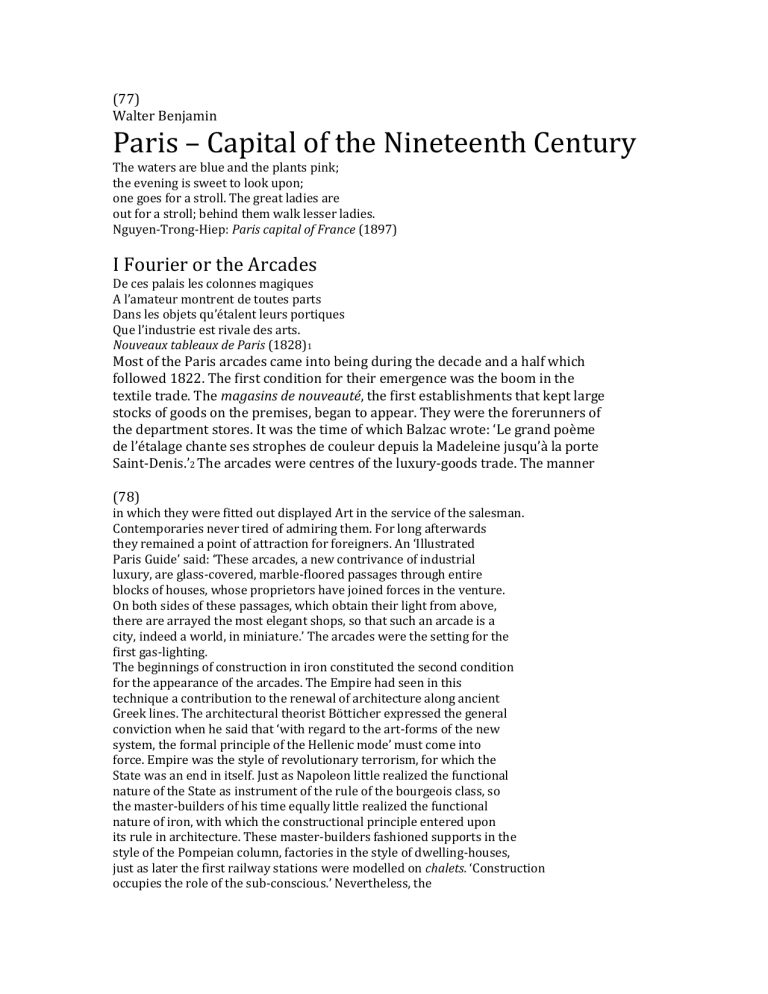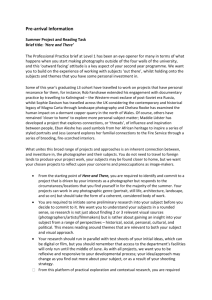Walter Benjamin: Paris, Capital of the Nineteenth Century

(77)
Walter Benjamin
Paris – Capital of the Nineteenth Century
The waters are blue and the plants pink; the evening is sweet to look upon; one goes for a stroll. The great ladies are out for a stroll; behind them walk lesser ladies.
Nguyen-Trong-Hiep: Paris capital of France (1897)
I Fourier or the Arcades
De ces palais les colonnes magiques
A l’amateur montrent de toutes parts
Dans les objets qu’étalent leurs portiques
Que l’industrie est rivale des arts.
Nouveaux tableaux de Paris (1828)
1
Most of the Paris arcades came into being during the decade and a half which followed 1822. The first condition for their emergence was the boom in the textile trade. The magasins de nouveauté, the first establishments that kept large stocks of goods on the premises, began to appear. They were the forerunners of the department stores. It was the time of which Balzac wrote: ‘Le grand poème de l’étalage chante ses strophes de couleur depuis la Madeleine jusqu’à la porte
Saint-Denis.’
2
The arcades were centres of the luxury-goods trade. The manner
(78)
in which they were fitted out displayed Art in the service of the salesman.
Contemporaries never tired of admiring them. For long afterwards they remained a point of attraction for foreigners. An ‘Illustrated
Paris Guide’ said: ‘These arcades, a new contrivance of industrial luxury, are glass-covered, marble-floored passages through entire blocks of houses, whose proprietors have joined forces in the venture.
On both sides of these passages, which obtain their light from above, there are arrayed the most elegant shops, so that such an arcade is a city, indeed a world, in miniature.’ The arcades were the setting for the first gas-lighting.
The beginnings of construction in iron constituted the second condition for the appearance of the arcades. The Empire had seen in this technique a contribution to the renewal of architecture along ancient
Greek lines. The architectural theorist Bötticher expressed the general conviction when he said that ‘with regard to the art-forms of the new system, the formal principle of the Hellenic mode’ must come into force. Empire was the style of revolutionary terrorism, for which the
State was an end in itself. Just as Napoleon little realized the functional nature of the State as instrument of the rule of the bourgeois class, so the master-builders of his time equally little realized the functional nature of iron, with which the constructional principle entered upon its rule in architecture. These master-builders fashioned supports in the style of the Pompeian column, factories in the style of dwelling-houses, just as later the first railway stations were modelled on chalets. ‘Construction occupies the role of the sub-conscious.’ Nevertheless, the
concept of the engineer, which came originally from the Revolutionary
Wars, began to gain ground, and the struggles between builder and decorator, Ecole Polytechnique and Ecole des Beaux Arts, began.
With iron, an artificial building material appeared for the first time in the history of architecture. It went through a development whose tempo accelerated during the course of the century. This received its decisive impulse when it turned out that the locomotive, with which experiments had been made since the end of the ’twenties, could only be utilized on iron rails. The rail was the first iron unit of construction, the forerunner of the girder. Iron was avoided for dwelling-houses, and made use of for arcades, exhibition halls, railway stations—buildings which served transitory purposes. Simultaneously, the architectonic areas in which glass was employed were extended. But the social conditions for its increased utilization as a building material only came into being a hundred years later. In Scheerbart’s Glass Architecture
(1914) it still appeared in the context of the Utopia.
* * *
1 ‘
The magic columns of these palaces show to the connoisseur on every side, in the articles which their portals display, that industry rivals the arts.’
2
‘The great poem of display recites its stanzas of colour from the Madeleine to the gate of Saint-Denis.’
(79)
Chaque époque rêve la suivante
Michelet: Avenir! Avenir!
3
To the form of the new means of production, which to begin with is still dominated by the old (Marx), there correspond images in the collective consciousness in which the new and the old are intermingled.
These images are ideals, and in them the collective seeks not only to transfigure, but also to transcend, the immaturity of the social product and the deficiencies of the social order of production. In these ideals there also emerges a vigorous aspiration to break with what is outdated— which means, however, with the most recent past. These tendencies turn the funtasy, which gains its initial stimulus from the new, back upon the primal past. In the dream in which every epoch sees in images the epoch which is to succeed it, the latter appears coupled with elements of prehistory—that is to say of a classless society. The experiences of this society, which have their store-place in the collective unconscious, interact with the new to give birth to the utopias which leave their traces in a thousand configurations of life, from permanent buildings to ephemeral fashions.
These relationships became discernible in the Utopia devised by
Fourier. Their innermost origin lay in the appearance of machines. But this fact was not expressed directly in their utopian presentation; this derived both from the amorality of the market society and from the false morality mustered to serve it. The phalanstery was to lead men back into relations in which morality would become superfluous. Its highly complicated organization resembled machinery. The imbrications of the passions, the intricate combination of the passions
mécanistes with the passion cabaliste, were primitive analogies based on the machine, formed in the material of psychology. This machinery, formed of men, produced the land of Cockaigne, the primal wishsymbol, that Fourier’s Utopia had filled with new life.
In the arcades, Fourier had seen the architectonic canon for the phalanstery.
Their reactionary transformation at Fourier’s hands was characteristic: while they originally served social ends, with him they became dwelling-places. The phalanstery became a city of arcades. Fourier established in the narrow formal world of the Empire the highlycoloured idyll of Biedermeier. Its fading brilliance lasted until Zola.
The latter took over Fourier’s ideas in his Travail, just as he took his leave of the arcades in Thérèse Raquin.
—Marx broke a lance on Fourier’s behalf, defending him from Carl
Grün, and stressed his ‘gargantuan concept of man’. He also turned his attention to Fourier’s humour. As a matter of fact, Jean Paul in his
Levana is as related to Fourier the pedagogue as Scheerbart in his Glass
Architecture is to Fourier the creator of Utopias.
* * *
3
‘Every epoch dreams its successor.’ Michelet: Future! Future!
(80)
II Daguerre or the Dioramas
Soleil, prends garde à toi!
A. J. Wiertz: Oeuvres Littéraires
(Paris 1870)
4
With construction in iron, architecture began to outgrow art; painting did the same in its turn with the dioramas. Preparation for the dioramas reached its peak just at the moment when the arcades began to appear.
Tireless efforts had been made to render the dioramas, by means of technical artifice, the locus of a perfect imitation of nature. People sought to copy the changing time of day in the countryside, the rising of the moon, or the rushing of the waterfall. David counselled his pupils to draw from Nature in their dioramas. While the dioramas strove to produce life-like transformations in the Nature portrayed in them, they foreshadowed, via photography, the moving-picture and the talkingpicture.
Contemporary with the dioramas there was a dioramic literature.
Le livre des Cent-et-Un, Les Français peints par eux-mêmes, Le diable à Paris,
La grande ville belonged to this. These books were a preparation for the bellettristic collective work for which Girardin created a home in the
’thirties with the feuilleton. They consisted of individual sketches whose anecdotal form corresponded to the plastically arranged foreground of the dioramas, and whose documentary content corresponded to their painted background. This literature was socially dioramic too. For the last time the worker appeared, away from his class, as a stageextra in an idyll.
The dioramas, which signalled a revolution in the relationship of art to technology, were at the same time the expression of a new attitude to life. The town-dweller, whose political supremacy over the countryside was frequently expressed in the course of the century, made an attempt to bring the country into the town. In the dioramas, the town was transformed into landscape, just as it was later in a subtler way for the flâneurs. Daguerre was a pupil of the diorama-painter Prévost, whose establishment was situated in the Arcade of the Dioramas.
Description of the dioramas of Prévost and of Daguerre. In 1839
Daguerre’s diorama was burned down. In the same year he announced
the invention of the daguerreotype.
Arago presented photography in a speech in the Assembly. He assigned to it its place in the history of technical science. He prophesied its scientific applications. Whereupon the artists began to debate its artistic value. Photography led to the destruction of the great professional standing of the miniature-portraitists. This did not happen purely for economic reasons. The early photography was artistically superior to miniature-portraiture. The technical reason for this lay in the long exposure time, which necessitated the most intense concentration on the part of the subject. The social reason for it lay in the circumstance that the first photographers belonged to the avant-garde and that their clientele for the most part came from it. Nadar’s lead over his professional colleagues was demonstrated when he embarked on
4
‘Sun, look out for yourself.’
(81) taking snapshots in the Paris sewers. Thus for the first time discoveries were required of the lens. And its significance became all the greater as, in the light of the new technical and social reality, the subjective contribution to artistic and graphic information was seen to be increasingly questionable.
The World Exhibition of 1855 was the first to have a special exhibit called ‘Photography’. In the same year Wiertz published his great article on photography, in which he assigned to it the philosophical enlightenment of painting. He understood this enlightenment, as his own paintings show, in a political sense. Wiertz can thus be designated as the first person who, if he did not foresee, at least helped to pave the way for montage, as the agitational utilization of photography. As the scope of communications increased, the informational importance of painting diminished. The latter began, in reaction to photography, firstly to emphasize the coloured elements of the image. As Impressionism gave way to Cubism, painting created for itself a broader domain, into which for the time being photography could not follow it. Photography in its turn, from the middle of the century onwards, extended enormously the sphere of the market-society; for it offered on the market, in limitless quantities, figures, landscapes, events which had previously been utilizable either not at all, or only as a picture for one customer. And in order to increase sales, it renewed its objects by means of modish variations in camera-technique, which determined the subsequent history of photography.








